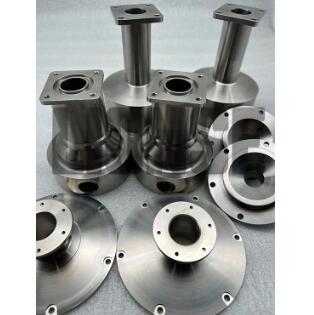The Manufacturing Process of Titanium Parts for Marine Equipment
2024-08-29
Titanium has become a cornerstone of marine engineering, prized for its exceptional strength, corrosion resistance, and lightweight properties. But what goes into making titanium parts for marine equipment? In this blog, we’ll take a closer look at the manufacturing process of titanium components, from raw material to finished product, and explore how these parts are engineered to meet the demanding standards of marine applications.
Sourcing Titanium: From Ore to Metal
The journey of titanium parts begins with the extraction of titanium ore, primarily rutile or ilmenite. These ores are mined and then processed to extract titanium dioxide (TiO2). The most common method for refining titanium is the Kroll process, where titanium dioxide is converted into titanium tetrachloride (TiCl4) and then reduced to metallic titanium using magnesium or sodium.
The result is a porous form of titanium known as titanium sponge. This sponge is melted in a vacuum or an inert atmosphere to remove impurities, producing pure titanium ingots. These ingots are then processed further to create titanium alloys, which are used in various industrial applications, including marine equipment.
Alloying and Forming Titanium Parts
Titanium by itself is a remarkable metal, but its properties can be enhanced by alloying it with other elements like aluminum, vanadium, or molybdenum. These alloys improve specific characteristics such as strength, ductility, and resistance to corrosion or heat.
Once the desired alloy composition is achieved, the titanium is ready to be formed into parts. The most common forming methods include:
- Forging: In forging, titanium ingots are heated and then hammered or pressed into the desired shape. This process improves the mechanical properties of the titanium, making it stronger and more durable. Forged titanium parts are often used in critical marine components like propeller shafts and fasteners.
- Machining: Titanium alloys can be machined into precise components using techniques such as milling, turning, and drilling. Machining titanium requires specialized tools and techniques due to its hardness and tendency to work harden. The resulting parts are used in various marine applications, including custom connectors and brackets.
- Casting: Although less common due to the challenges of casting titanium, this method is used for complex shapes that are difficult to achieve through forging or machining. Titanium casting requires high temperatures and a controlled environment to prevent contamination, but it allows for the production of intricate marine parts.
- Welding: Welding titanium requires careful control of the atmosphere to prevent contamination, as titanium is reactive at high temperatures. Specialized welding techniques, such as gas tungsten arc welding (GTAW), are used to join titanium parts. Welded titanium structures are used in marine applications where a seamless, corrosion-resistant join is essential.
Surface Treatment and Finishing
Once the titanium parts are formed, they undergo surface treatment and finishing processes to enhance their properties. Common treatments include:
- Passivation: This process involves treating the titanium surface with an acid to enhance its natural oxide layer, increasing its corrosion resistance. Passivation is especially important for marine applications where parts are exposed to saltwater.
- Anodizing: Anodizing titanium involves creating a controlled oxide layer on the surface by applying an electrical current. This layer can be customized in thickness and color, improving both the appearance and durability of the part.
- Polishing: Polishing titanium parts not only improves their appearance but also reduces the risk of corrosion by creating a smooth, defect-free surface.
Quality Control and Testing
Given the critical nature of marine applications, titanium parts undergo rigorous quality control and testing before being approved for use. This includes:
- Ultrasonic Testing: Ultrasonic waves are used to detect internal flaws or cracks in titanium parts, ensuring their structural integrity.
- X-ray Inspection: X-ray technology is used to inspect the internal structure of titanium castings and welds, checking for porosity or defects that could compromise performance.
- Corrosion Testing: Parts are subjected to accelerated corrosion testing to verify their resistance to saltwater and other marine conditions.
The Final Assembly
After passing quality control, titanium parts are ready for final assembly into marine equipment. Whether it’s a propeller shaft, a hull fitting, or a heat exchanger, each part plays a crucial role in the overall performance and reliability of the marine system. The use of titanium ensures that these components can withstand the harsh marine environment and continue to perform over the long term with minimal maintenance.
Conclusion
The manufacturing process of titanium parts for marine equipment is a complex and highly specialized endeavor, involving everything from alloying and forming to surface treatment and rigorous testing. Each step is crucial in ensuring that the final product meets the exacting standards required for marine applications. As the demand for durable, corrosion-resistant materials in marine engineering grows, the role of titanium in producing reliable, long-lasting marine equipment will only continue to expand.



